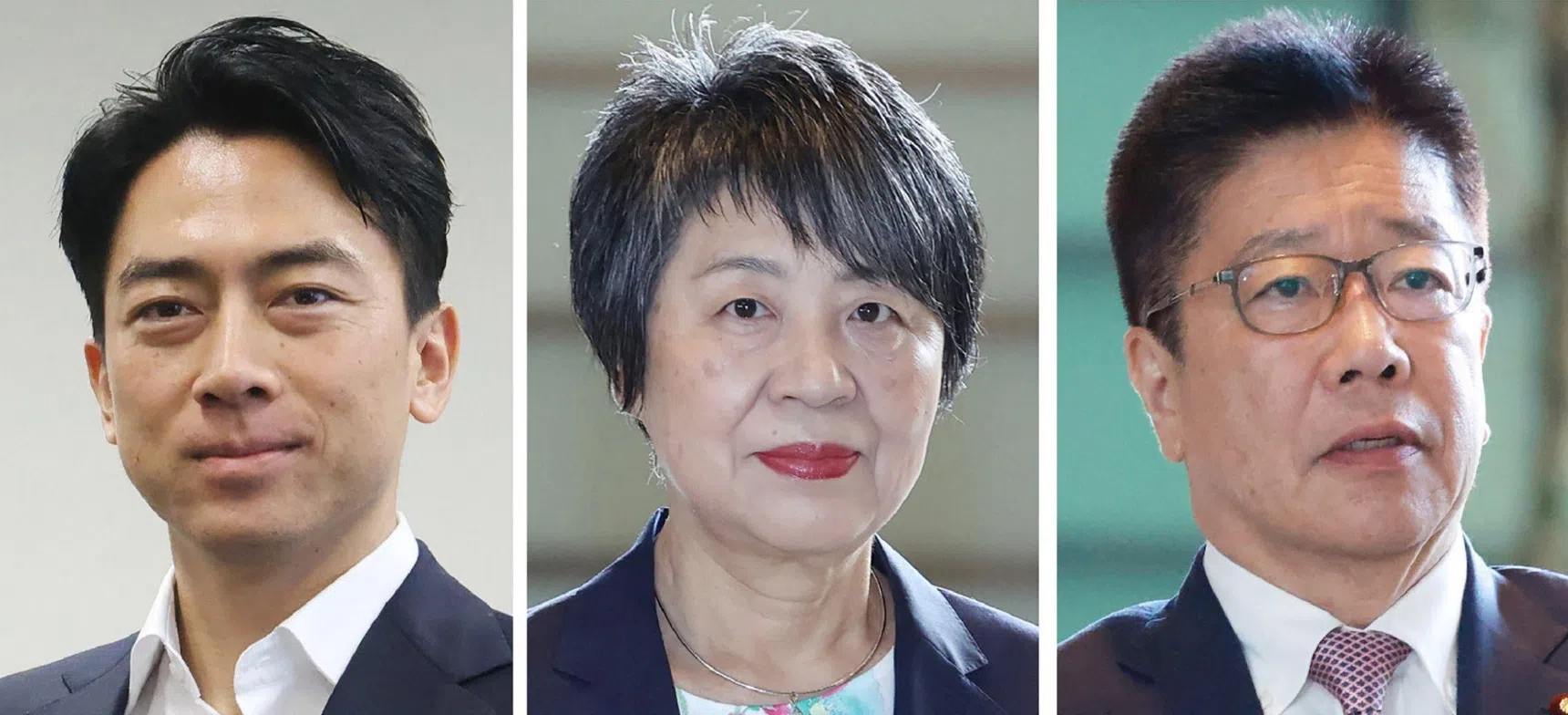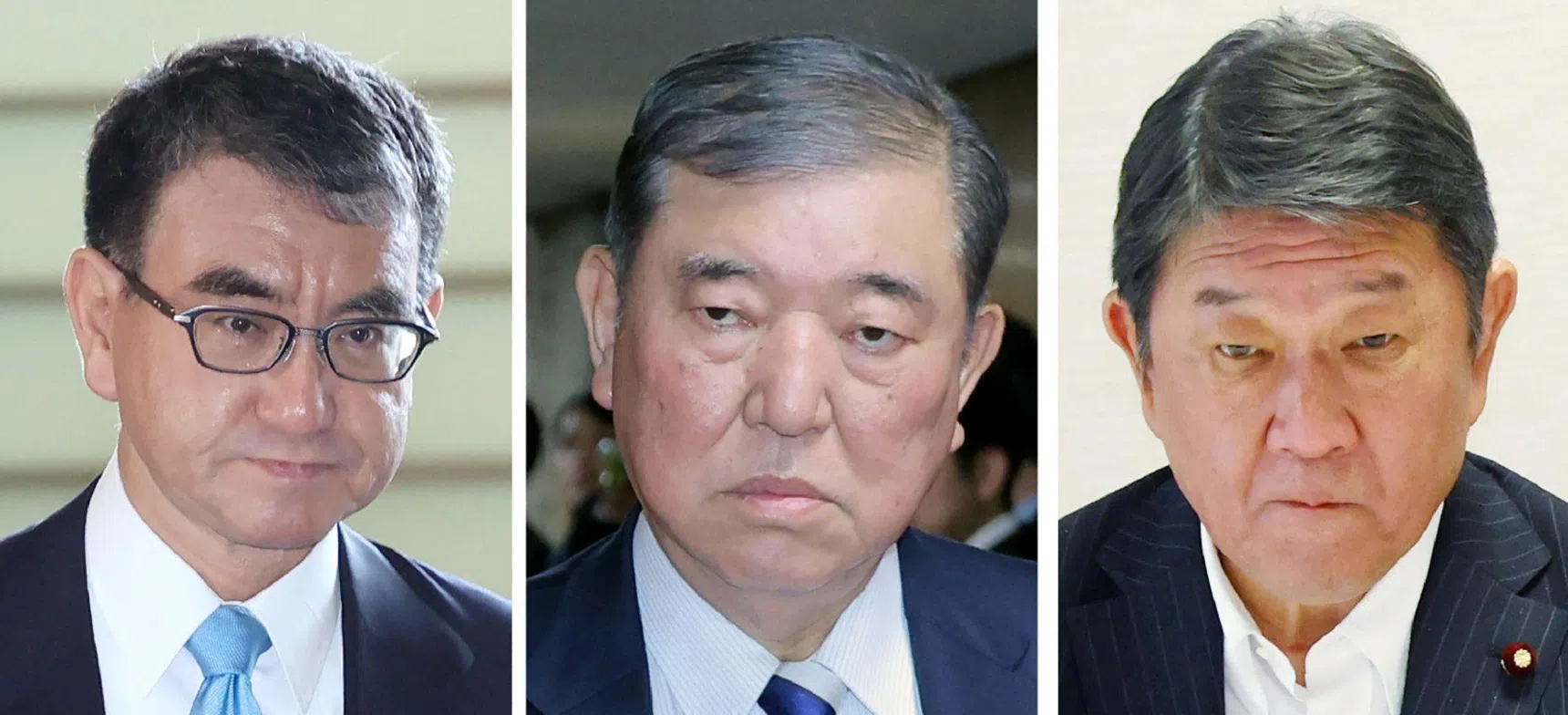Japan PM race kicks off with record 9 candidates, as ruling LDP aims to rehabilitate image
Sign up now: Get ST's newsletters delivered to your inbox

Japan's ruling Liberal Democratic Party leadership election candidates preparing to give speeches at the party headquarters in Tokyo on Sept 12.
PHOTO: AFP
Follow topic:
TOKYO – Japan may soon get its youngest leader or first woman in the nation’s top job, as a record nine candidates are in the fight to succeed Prime Minister Fumio Kishida.
The ruling Liberal Democratic Party (LDP) on Sept 12 formally flagged off its leadership election, with voting on Sept 27. Given its majority in the Diet, as Japan’s Parliament is known, the party’s leader is by default the prime minister.
Unlike past contests that were mostly predictable affairs, this battle is far from clear-cut, and is expected to expose the chasm between the party’s progressives and conservatives.
Pundits have named as front runners five-term lawmaker and former environment minister Shinjiro Koizumi, 43, as well as nine-term lawmaker and incumbent economic security minister Sanae Takaichi, 63.
Both are capable of portraying themselves as agents of change for an LDP that is keen to rehabilitate its stodgy image as a political party of middle-aged men with vested interests. The party has been further tarnished by a massive political slush funding scandal
If he prevails, Mr Koizumi, a political blueblood and son of former maverick prime minister Junichiro Koizumi (2001-2006), will by far be the nation’s youngest leader, lowering the record held by the late Mr Shinzo Abe, who was 52 when he first took office in 2006.
A victory for Ms Takaichi, an Abe protege, would be historic for Japan given her gender.
Both have radically different social policy views, with Mr Koizumi far more progressive than Ms Takaichi.
But they have one thing in common: Both are regular visitors to the controversial Yasukuni Shrine, which is a symbol of Japan’s wartime militarism as it enshrines 14 Class A war criminals alongside other war dead.
The other seven contenders are:
Mr Yoshimasa Hayashi, 63, chief Cabinet secretary
Mr Shigeru Ishiba, 67, former defence minister
Ms Yoko Kamikawa, 71, foreign minister
Mr Katsunobu Kato, 68, former chief Cabinet secretary
Mr Takayuki Kobayashi, 49, former economic security minister
Mr Taro Kono, 61, digital minister
Mr Toshimitsu Motegi, 68, LDP secretary-general
The LDP race caps a busy political season in Japan, and comes after the embattled Mr Kishida, 67, decided to bow out and not run for re-election most unpopular leader
LDP coalition partner Komeito is likewise undergoing a leadership change on Sept 28, as chief Natsuo Yamaguchi, 72, hands over the reins to his No. 2, Mr Keiichi Ishii, 66.
The main opposition Constitutional Democratic Party of Japan is also holding party elections on Sept 23, when it will choose its leader among four candidates, including former prime minister Yoshihiko Noda (2011-2012).
But it is the LDP contest that has been dominating headlines.
Mr Kishida and his Cabinet will resign en masse for the winner to be sworn in as PM at an extraordinary Diet session, likely on Oct 1. A new Cabinet is expected the same week.
The odds are that the new PM will dissolve the Lower House for a general election pretty much immediately to secure a public mandate – probably even before Japan’s security ally, the United States, goes to the polls on Nov 5.
Even if the new PM does not call a snap poll, a general election must be called by October 2025, when the four-year Lower House term expires. The Upper House, which carries fixed six-year terms, cannot be dissolved, and an election must be held in July 2025.
The LDP has made no secret that whoever is victorious will be the party’s “face of the elections”. So, although the public does not have a direct say in the Sept 27 vote, LDP lawmakers will likely have an eye on how the PM hopefuls fare in opinion polls.
In current surveys, Mr Koizumi and Mr Ishiba often trade places at the top, with Ms Takaichi coming in at a solid third.

(From left) Ms Sanae Takaichi, Mr Takayuki Kobayashi and Mr Yoshimasa Hayashi.
PHOTO: AFP
Mr Koizumi, a hobbyist surfer whose brother is popular actor Kotaro Koizumi, presents himself as a reformist who wants to fully deregulate ride-sharing services and allow married couples to keep their respective surnames. But his critics argue that he is untested, given his relative inexperience.
Ms Takaichi, meanwhile, has vowed to carry the late Mr Abe’s torch. Her traditional conservatism could be a liability – she is against married couples having different surnames – in an era when the public is agitating for more diversity.
Mr Ishiba is on his fifth and, he says, final bid for the top job. He is highly personable and popular – and a Reuters poll of Japan Inc published on Sept 12 showed he is the top corporate choice for PM

(From left) Mr Shinjiro Koizumi, Ms Yoko Kamikawa and Mr Katsunobu Kato.
PHOTO: AFP
The race could yet throw up surprises. The loudest cheers among assembled LDP members at party headquarters on Sept 12 were reserved for Mr Motegi, a former foreign minister who is campaigning on the populist promise not to raise taxes to fund big-ticket policy items in defence and childcare.
And among the others, Mr Kobayashi, a conservative four-term lawmaker, has the support of junior- and mid-ranked LDP politicians; Mr Kono is Japan’s most followed politician on social media and was second to Mr Kishida in 2021; Ms Kamikawa, while the oldest in the race, is seen as a steady hand without any political baggage.
Ultimately, observers are watching if the LDP can, through the 15-day campaign, demonstrate a clean break from its scandal-ridden, faction-driven past.

(From left) Mr Taro Kono, Mr Shigeru Ishiba, and Mr Toshimitsu Motegi.
PHOTO: AFP
Dr Mikitaka Masuyama of the National Graduate Institute for Policy Studies expects plenty of backroom jockeying as candidates and their supporters strike deals with one another. Even if they do not win, this could still influence the vote such that the party does not veer too far to either the left or the right.
Sophia University Professor Koichi Nakano, now a visiting scholar at the Weatherhead programme on US-Japan Relations at Harvard University, sees this as a “perfect storm”.
“Lawmakers want to get re-elected (in national polls), and they know a popular leader is better than an unpopular one,” he said. “But they are also thinking about factional loyalty, about who brought them into politics, about who is likely to promote them.”
How Japan’s next Prime Minister will be chosen
Nine contenders are duking it out to become Japan’s next Prime Minister, as the ruling Liberal Democratic Party (LDP) on Sept 12 flagged off its campaign sprint for the vote on Sept 27.
They were confirmed as nominees having secured the requisite 20 endorsements from fellow LDP parliamentarians.
Over 15 days, they will traverse the country to hold policy debates and stump speeches, as well as to lobby local party chapters.
The president of the LDP, as the dominant party in the Diet, is by default Japan’s Premier. The race thus assures the LDP of outsized media coverage, with debates expected on policy issues such as the economy, ageing, diplomacy, and the right for married couples to keep separate surnames.
At stake on Sept 27 are 734 votes. The 367 elected LDP lawmakers will each hold one vote, while the other 367 will be proportionally assigned to the 1.1 million rank-and-file members across party chapters in all 47 prefectures.
In the likely scenario that no single candidate manages to score an outright majority, a run-off election will be held on the same day between the top two finalists.
In this event, the vote will be significantly skewed towards the 367 elected parliamentarians, who will still each get one ballot. The 47 LDP prefectural chapters, meanwhile, will each get one vote for a total of 414 votes.
This has the potential to change the dynamics of the race, as evident in the LDP election in September 2012, when the party was in opposition.
Mr Shigeru Ishiba – now making his fifth run for the top job – came up tops in the first round among five contenders, with Mr Shinzo Abe placing second.
But Mr Abe rode on strong parliamentarian support to pip Mr Ishiba in the run-off to win, paving the way for him to become Japan’s longest-serving Prime Minister after the LDP wrestled back power three months later.


